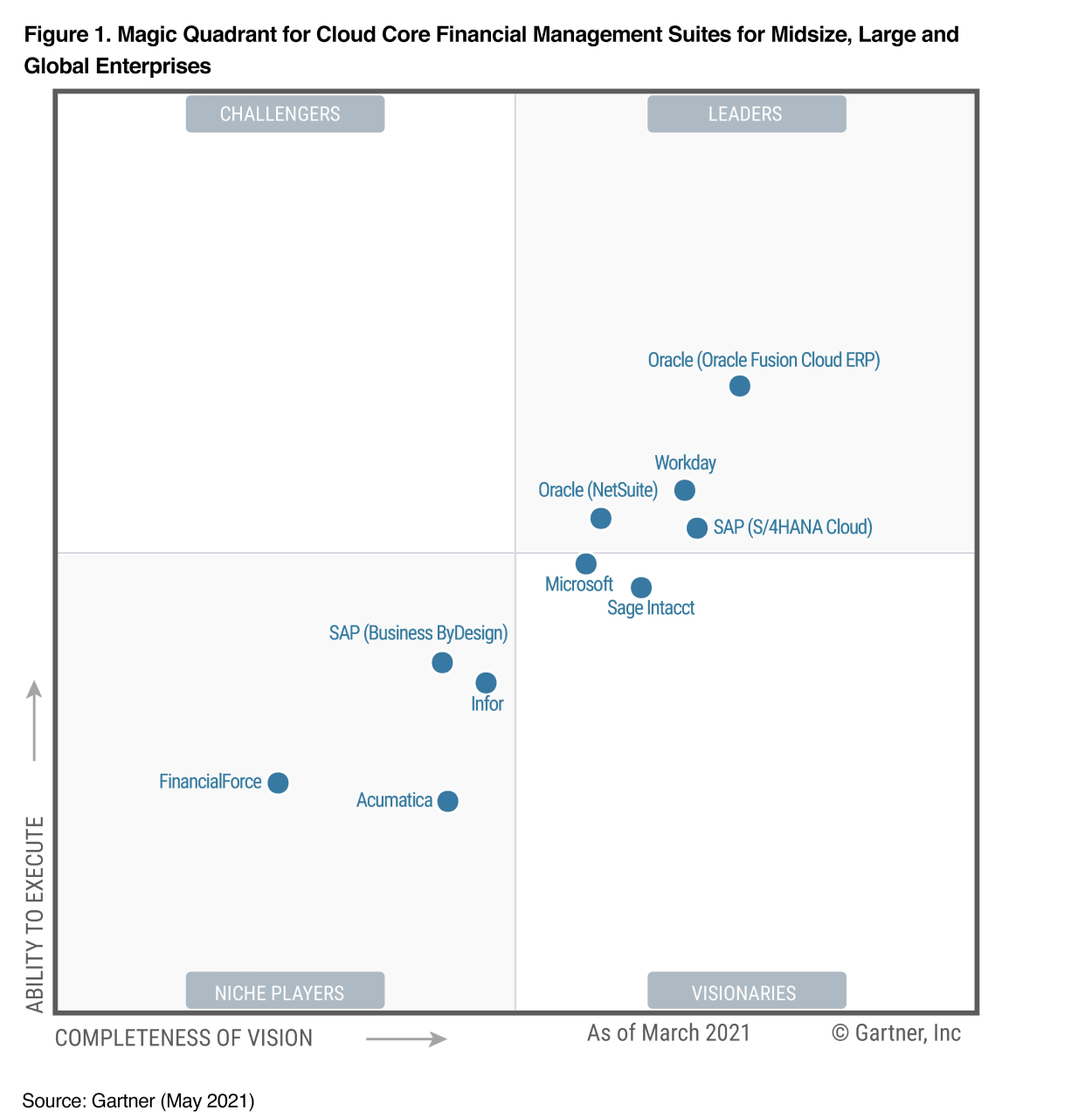A Critical Analysis of the Gartner’s Cloud Core Financial Management Suites Magic Quadrant
Executive Summary
- Gartner produces a Cloud Core Financial Management Suites for Midsize, Large and Global Enterprises MQ.
- We evaluate this MQ to see if it holds up to scrutiny.

Introduction
Gartner produces a large number of Magic Quadrants highly. Curiously, while these Magic Quadrants are prevalent topics of discussion and determine many purchase decisions, each one that we have evaluated has significant problems that make us question the validity of this highly popular product.
The Cloud Core Financial Management Suites for Midsize, Large and Global Enterprises Magic Quadrant
The following is the 2021 version of Gartner’s Cloud Core Financial Management Suites for Midsize, Large and Global Enterprises Magic Quadrant.

This is a strangely named MQ. This is an MQ for ERP systems, and “ERP systems” are what the vendors that sell these systems call them.
Two things immediately pop out to us when reading this MQ.
Observation #1: An MQ Exclusively for Only The Large Vendors
There are many cloud ERP vendors. However, only ten companies made a list, and nearly every one of the vendors is large. The only one that is not is Acumatica.
Why?
Now one might state that this is an MQ for midsize companies and up — so all the way to global. However, that would not be a good defense, as ByDesign, by SAP, is not implemented by large companies (it may be implemented by a smaller division of a large company, but that is, of course, not the same thing).
Gartner has stated that which vendors pay has no bearing on who appears or how they appear in the MQs — so why would this MQ be listed to only ten of the largest ERP vendors?
So many smaller ERP vendors offer much better pricing and are easier to deal with than these companies.
I can confidently say that it makes no sense for midsize companies and up to limit’s their software selection to these vendors. For one reason, some vendors offer better industry functionality, and one of these is ProcessPro, for process industry manufacturing.
We have no relationship with ProcessPro and are not saying this because we desire to promote them.
According to Gartner, they recommend that their clients limit their purchases to these companies. This is the universe of cloud ERP providers, which is not valid, and keeps companies from observing and considering other options that are better for different types of workloads — including, of course, price. But more than this, there is a strong relationship between the size of a vendor and how difficult they are to work with.
Observation #2: Oracle Does Not Have the Best Cloud ERP System
The fact that Oracle is the top-rated vendor in this MQ means the entire MQ is in error. Oracle’s migration of functionality from multiple on-premises applications has been a problem for decades. I have reviewed Oracle’s ERP Cloud and consulted with companies that use Oracle ERP Cloud, and the customer satisfaction with the product is low. Oracle is known to sell Oracle ERP Cloud, record the license as cloud, but then have the company go and implement one of its on-premises ERP systems.
Observation #3: No Open Source and No Custom Developed ERP
Gartner represents commercial software. Open source does not have the money to pay Gartner, so Gartner likes to pretend that open source does not exist. This reaches comedic proportions in the Can Anyone Make Sense fo the ODMS Magic Quadrant?, where Gartner has to twist itself into a pretzel to exclude highly used databases from its MQ. This is strong evidence that Gartner is not including options that would be good for many software buyers from its MQs. Open source ERP systems allow for a great deal of control and customization flexibility that no commercial ERP vendor can match, as commercial ERP vendors do not provide the source code. And this, of course, relates to the topic of customization. Once an ERP system is sold and implementation begins, the ERP vendors set about getting the code from pre-existing systems rewritten into the ERP system, typically using the vendor’s tools. This implements a lock-in for the customer. Gartner will never explain this in its ERP MQs.
Furthermore, many companies have requirements that don’t fit many ERP systems. However, Gartner never addresses this — and Gartner force fits a commercial ERP system (and as I have discussed only from the vendors willing to pay) into every scenario. Some companies are better suited to custom developing their own “ERP system.” However, Gartner does not want its buyers to know this — and promotes a one size fits all approach on its customers — that is profit-maximizing to Gartner. Gartner has long diminished all custom-developed solutions because custom-developed solutions do not result in revenues for Gartner.
Once implementation begins, the ERP vendor sets about trying to convince the customer to use as much ERP functionality as possible, often overstating the fit between the standard functionality in the ERP system and the customer’s requirements. The consulting company or implementation “partner” is not a source of objectivity on this topic, as they are aligned with the ERP vendor. Therefore, the customer receives tainted information from both the ERP vendor and the vendor-aligned consulting firm. This result is that ERP systems go live with significant misfitting functionality vis-a-vis requirements. Neither ERP vendors nor ERP consultants want this fact known or incorporated into an understanding of ERP failure rates.
Sufficit to say, some of the most important topics around ERP software selection, custom development, and around open source are entirely left out of Gartner’s ERP MQs due to financial bias and financial ties.
Conclusion
Companies use Gartner Magic Quadrants without understanding how Gartner arrives at their results. Gartner profit maximizes — rather than provides honest research. This means that Gartner works backward from how it can get paid the most (including fees from vendors and buyers), and they determine their views and the Magic Quadrants based upon this. This is why this MQ has the results that it does. The vendors in this MQ can afford to pay Gartner the most. It does not matter to Gartner whether these vendors are challenging to work with or are more expensive because the MQ is not designed around the needs of the buyers but is designed around the needs of Gartner. From the vendor’s perspective, they are also willing to pay Gartner to help “narrow the field.” That is, in a monopolistic fashion, the largest vendors are eager to pay not only to be included but to have a price of admission that is sufficiently high that it keeps smaller and better value vendors out of the Magic Quadrant. This drives buyers to the most expensive solutions and causes vendors that are easier to deal with and lower cost to be sidestepped as not enterprise-ready. Curiously, the scheme behind the Magic Quadrant has not been more widely exposed.